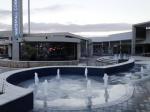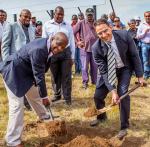More shopping centres coming
At least 30 new shopping centres are expected to open their doors this year and next.
Despite consumers’ seemingly waning appetite for retail therapy, at least 30 new shopping centres, varying in size from 5000m² right up to 120000m², are expected to open their doors this year and next.
That is on top of the more than 20 new centres that have already been completed since mid-2013, according to the latest figures from the SA Council of Shopping Centres (SACSC).
In fact, industry estimates are that close to 6mm² of new retail space — equivalent to about 42 Sandton Cities — would have been added to the market over the 10 years to 2016. That represents growth of 35%, taking the total mall space in SA from 18mm² in 2006 (Macquarie Research figures) to around 24mm² in 2016.
Sizeable new malls that were completed over the past two years include Sasol Pension Fund and Pivotal Property Fund’s 76000m² Cradlestone Mall on the West Rand; Billion Group’s 76000m² Forest Hill in Centurion; Redefine Properties’ 65000m² Matlosana Mall in Klerksdorp; the Resilient Group’s 60000m² Secunda Mall and 45000m² Tubatse Crossing in Burgersfort; and Atterbury’s Newtown Junction in downtown Johannesburg, which includes a 38000m² retail component.
Last month, Abacus Asset Management and Billion Group opened the 90000m² Baywest Mall on the western outskirts of Port Elizabeth. Around 210000 people flocked to the mall in its first four days of operation.
Not only is Baywest now the biggest mall in the Eastern Cape, it is also the largest new centre to open in SA since Atterbury built the Clearwater Mall on the West Rand in 2004.
There has clearly been no lack of demand for space from retailers, with 92% of Baywest Mall already let. International brands such as Swarovski, Lacoste, River Island, Express, Dune, Mamas and Papas, Superga, Timberland, Toss, Karaca, TM Lewin and Tom Tailor are all making their Eastern Cape debut at Baywest.
The mall, which was nine years in the making at a total construction cost of R2bn, will anchor what will become Baywest City, an entirely new suburb on a huge 320ha site that will eventually comprise 3000 freehold residential properties, 20000m² of offices, a hospital and two service stations.
Given the pace at which new retail space continues to be added to the market, coupled to ongoing pressure on consumer spending, the question arises whether developers and mall owners can still earn a decent return on new projects.
Abacus executive chairman Jaco Odendaal and Billion CEO Sisa Ngebulana both concede that profit margins on new developments are declining. Seven years ago developers could build new malls at initial yields (first year’s rental income as a percentage of capital value) of 9%-10%. “Today you are lucky if you get a yield of more than 7%,” says Ngebulana.
That’s not only because of rising supply and increased competition to sign tenants. Most national retailers are still keen to roll out new stores and expand existing ones in shopping centres they believe will dominate their catchment areas.
But Odendaal notes developers have to contend with a new set of costs which are having an impact on profitability. These include more demanding tenants, especially the large fashion retailers, who are insisting that developers provide more expensive store fit-outs; rising utility costs such as electricity, water and municipal rates; having to comply with new green building requirements; as well as the installation of generators.
Ngebulana says another cost that developers have to carry these days is the upgrade of surrounding infrastructure, given that local councils don’t have the money to build the road, water and sewerage infrastructure necessary to support large-scale developments.
At Baywest Mall, Billion and Abacus spent R200m (in addition to Sanral’s R100m) to build new road infrastructure.
Says Ngebulana: “There is still money to be made on new malls in select areas but one has to take a longer-term view. It takes at least three years for a mall to settle down. So you have to have deep pockets to sustain a centre through its teething period.”
Both Odendaal and Ngebulana believe that Baywest and Attacq’s 120000m² Mall of Africa, under construction in Midrand, may be the last two super-regional malls to be built in SA for at least the next 5-10 years.
The fact that new opportunities for growth in the local retail market are becoming scarcer is underlined by the trend among developers, retailers and listed property funds to grow their portfolios beyond SA’s borders.
However, Odendaal believes there is still room for more mid-sized malls in SA, particularly in higher-income urban areas. He says these centres are typically sized at 20000m²-25000m² and offer easy and safe access to convenience shopping within established residential nodes.
A key variable that could support the further addition of retail space is the extent to which international retailers continue to enter SA. The general view is that there are plenty of others waiting in the wings, looking to see how successful the early movers such as fashion brands Zara, Cotton On, Gap, Burberry, Topshop, Forever 21, soonto open H&M, and fast-food outlet Burger King will be.
However, divisional director of retail leasing at Broll Property Group, Preston Gaddy, says most new international entrants to SA, particularly fashion retailers, are interested only in malls that exceed 50000m².
Though there have been a few cases where international entrants have taken space in busy, small regional centres, Gaddy notes that the larger fashion retailers will place a handful of stores only in major metropolitan areas. “At this stage they won’t venture into outlying areas.”
He says European retailers are particularly keen to set up base in SA as a platform to potentially expand northwards into the rest of Africa, given the muted growth in consumer spending in their own markets.
“We are also seeing that many SA retailers are looking at partnering with international retail brands to expand their offering and diversity either in-store or in standalone stores.”
Marius Muller, CEO of the Public Investment Corp’s Pareto, which owns a number of large malls such as Menlyn Park in Pretoria, The Pavilion in Durban, Cresta and Westgate in Johannesburg, as well as a 25% stake in Sandton City, believes the next round of international tenants to enter SA will come from Turkey and the Middle East.
He says Pareto is now actively searching out new retailers from other territories beyond those already familiar to SA shoppers such as the UK, the US, Europe and Australia. “South Africans have had a taste of what is on offer from the world’s top retail brands andthey want more.”
Muller confirms that global retailers are very selective and mostly interested in welltrading regional and super-regional malls. However, the problem is that most dominant malls trade so well that they have a very low vacancy and cannot accommodate international retailers who often require big box spaces.
Muller expects SA mall owners to continue to invest in new retail space, particularly the extension and refurbishing of existing regional malls.
He notes Pareto is already busy with upgrades to accommodate more international retailers at, among others, Menlyn Park, Cresta and The Pavilion.

















